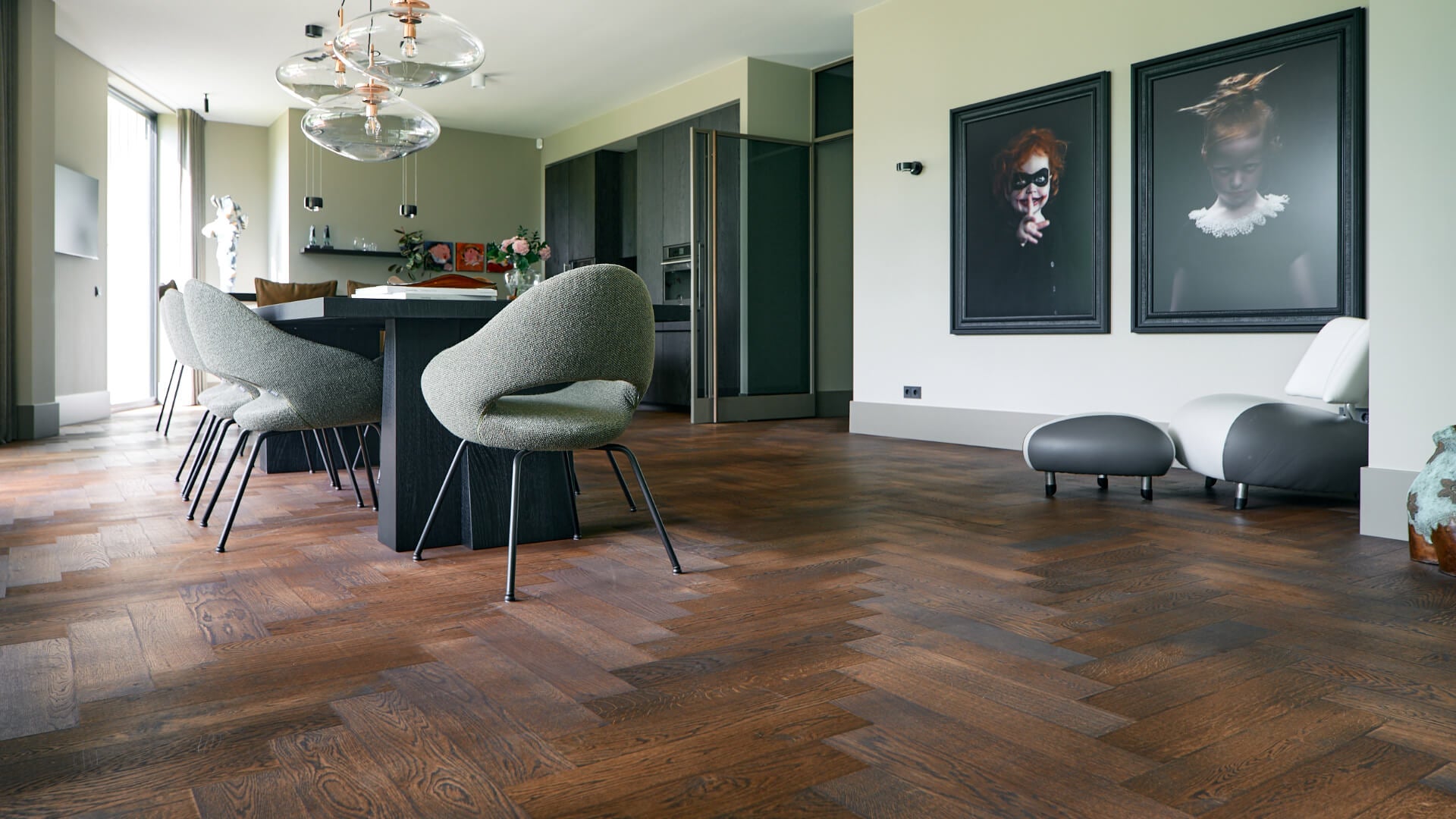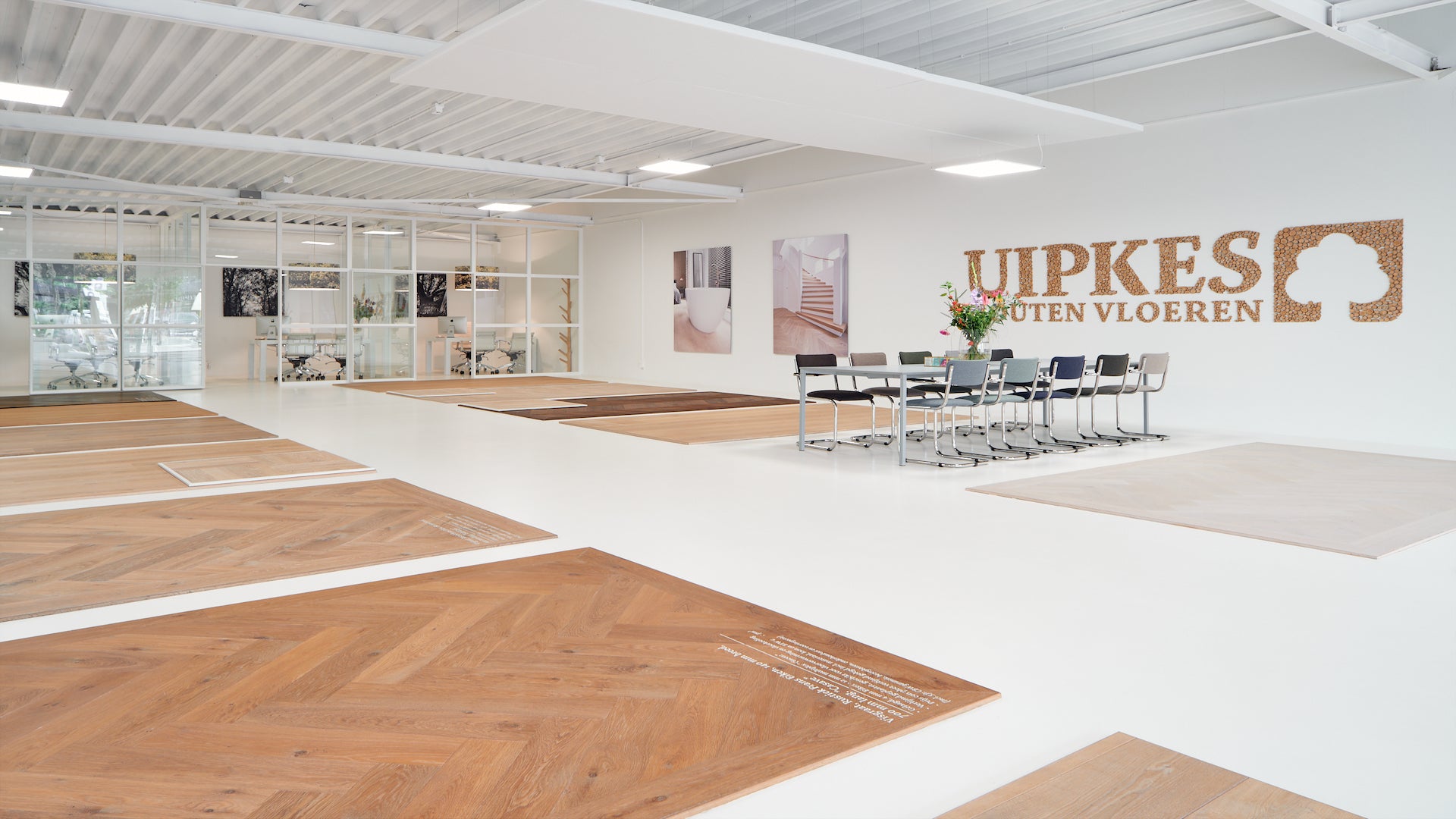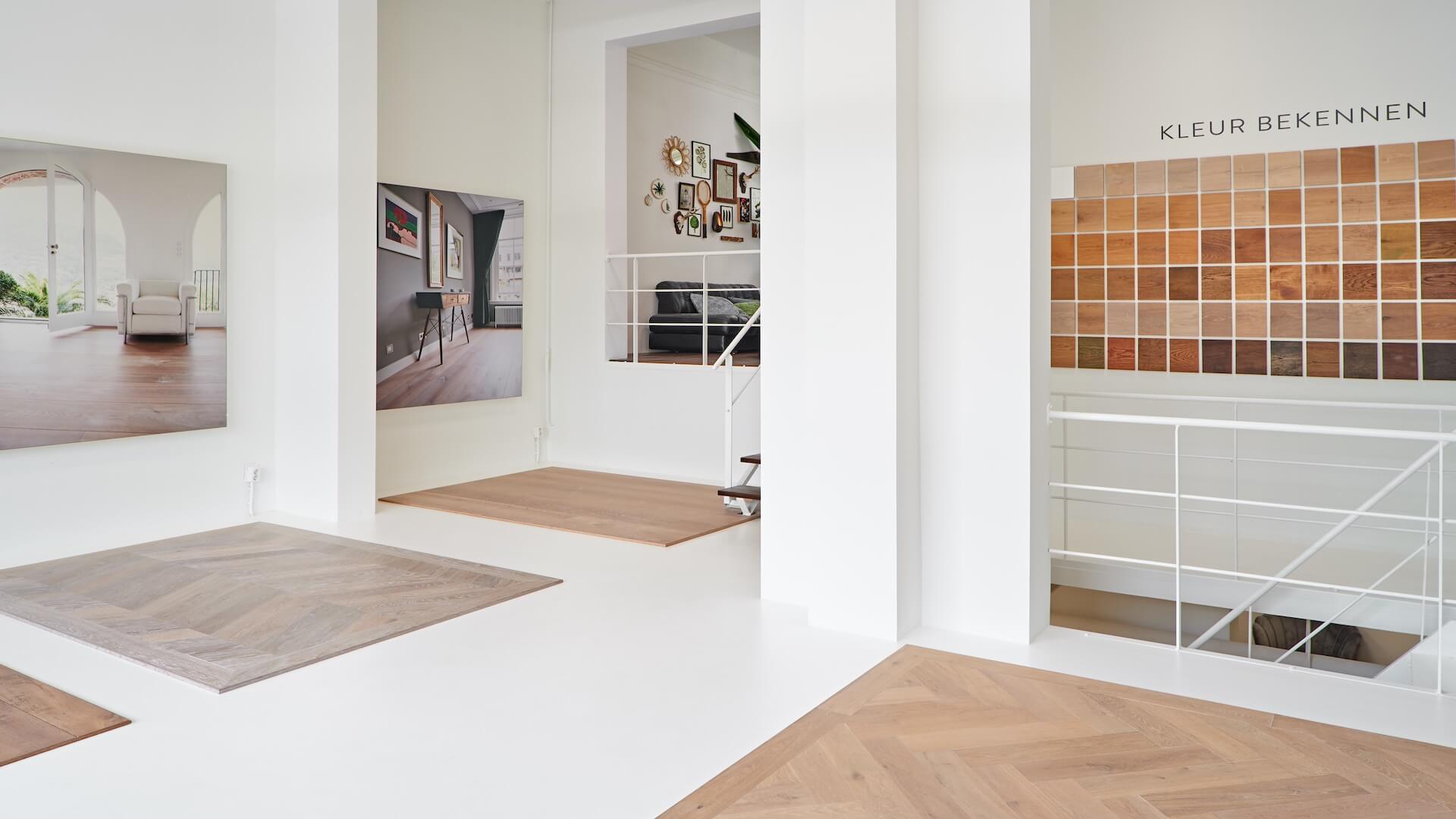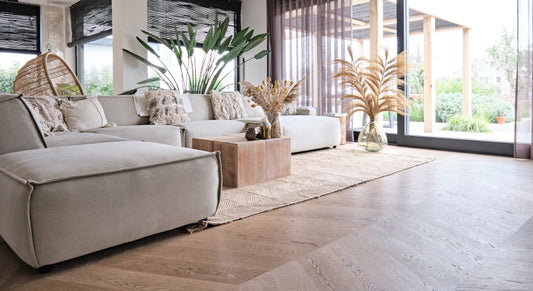De Kunst van Minder in Modern Interieur

Datum: 08 mei 2024
Leestijd: 9 minuten
Auteur: Uipkes Houten Vloeren
When we think of a modern interior, many of us immediately think of clean lines, neutral colors and a minimalist approach to design. But what makes an interior truly modern? And how has this style developed over the years into what it is today?
What is a modern interior?
Modern interior design has its roots in the early 20th century, with influences from various artistic and architectural movements, including Cubism. Known for its use of abstract, geometric shapes and saturated color tones, this movement has had a profound influence on what we consider modern design today.
The term 'modern' denotes not only an era or style, but also a way of thinking - a desire for innovation and breaking with tradition.
Key Elements of a Modern Interior
A modern interior contains a number of specific elements that together create a harmonious and functional living environment. The most important features of this popular interior style are explained below.
1. Functional Furniture
A modern interior is all about simplicity, functionality and clean lines. Furniture pieces are often sober in design but made of high-quality materials to guarantee durability and comfort.
Examples of this are sleek, straight sofas without decorations, minimalist chairs and functional tables where any form of decoration has been omitted in favor of function. This furniture is not only practical but also contributes to a visually peaceful environment.
2. Color scheme
A typical modern color scheme includes many neutral tones such as white, gray and black. These are sometimes complemented with accent colors in bold shades to add character and vibrancy.
Popular choices for accent colors include red, deep blue, or vibrant green, which are used in small doses to draw attention without disrupting the overall calm appearance.
3. Materials
Modern interior design uses a wide range of materials, ranging from traditional to more industrial. Natural materials such as wood, leather and stone are combined with glass, metal and polished concrete.
These materials bring warmth and texture to the room, creating a perfect balance between cool and comfortable. Each material is chosen for its aesthetic quality and functionality, often opting for durable and easy-to-maintain options.
4. Open Space and Natural Light
Modern interiors emphasize open spaces and a smooth transition between different living areas. The spatial layout focuses on functionality and minimalism, often avoiding unnecessary interior walls to create an airy and light environment.
Large windows play a crucial role in this style, not only to maximize natural light but also to bring the outdoors inside.
Laat je inspireren door ons gratis magazine
5. Minimalist Decoration
In a modern interior there is a clear preference for less decoration. Accessories are carefully chosen and often functional in nature.
Artworks are usually abstract, with large formats that serve as focal points in a room. Instead of several small decorations, a few striking items are chosen that enhance the color scheme and aesthetics of the room.
6. Geometric and Abstract Shapes
In modern interiors you often see sharp lines, right angles and geometric shapes. These can be reflected in everything from artwork on the walls to the shape of furniture and structural elements in the room.
7. Technology Integration
Modern living also involves the seamless integration of technology. Whether it is advanced home entertainment systems, smart home automation or integrated kitchen appliances, technology is integrated in such a way that it contributes to the sleek and unobtrusive appearance of the home.
Each of these elements contributes to the characteristic appearance and functionality of the modern interior. By following the principles of minimalism and functionality, you create a stylish yet comfortable living environment that will effortlessly withstand the test of time.
Houten vloeren passen perfect in een moderne, duurzame woning
Kom langs voor advies
The Role of Wooden Floors in a Modern Interior
Wooden floors play a vital role in modern interiors due to their natural beauty, durability and versatility. They offer a perfect balance between functionality and aesthetics, making them a favorite choice for many designers and homeowners. Below we show how wooden floors contribute to the appearance of a modern interior.
1. Natural Warmth and Radiance
Wooden floors bring an undeniable warmth that can soften modern spaces that can otherwise feel cold and sterile due to the use of industrial materials such as metal and concrete.
The natural textures and colors of wood create a visually pleasing and inviting atmosphere that complements the minimalist aesthetic of modern interiors.
2. Aesthetic Versatility
One of the biggest advantages of wooden floors is their versatility. They are available in a wide range of finishes, colors and patterns , meaning they can be adapted to almost any style.
From light oak to dark walnut, each wood specie offers unique tones and grains that add rich texture to the space. Wooden floors can also be installed in various patterns such as herringbone or chevron floor , adding an extra layer of design and sophistication.
3. Durability and Long Lifespan
Wooden floors are not only known for their beauty, but also for their durability.
With proper care and maintenance, wood floors can last for decades, making them an economically sensible investment for modern homes. Their timeless appeal ensures that they will not quickly go out of fashion, unlike some trend-sensitive floor coverings.
4. Ecologically Responsible
For the environmentally conscious homeowner, wood floors offer a sustainable choice. Many modern wooden floors come from sustainably managed forests, as is the case with Uipkes, or they are made from recycled materials. This is in line with the growing trend within modern interiors to make environmentally friendly and ethical design choices.

5. Integration with Other Modern Elements
Wooden floors work harmoniously with other characteristic elements of modern interiors, such as large glass windows, sleek metal details and soft fabrics.
They form a natural bridge between the different materials and textures used in modern spaces, creating a cohesive whole.
6. Compatibility with Underfloor heating
Another important advantage is the possibility of combining underfloor heating with wooden floors in modern interiors.
Underfloor heating provides efficient and uniform heating of the space without the presence of visible radiators, which can disrupt the sleek, minimalist design.
Various underfloor heating systems fit perfectly under wooden floors, allowing you to enjoy both the aesthetics and comfort of a warm floor. It is important to choose wood species and finishes that are resistant to heat expansion and contraction (see: the working of wood ) to ensure the durability of the floor.
7. Influence on the Spatial Experience
The choice of wood and the direction in which it is laid can influence the perception of space within a modern interior.
Light wood species can make a room feel larger and airier, while dark wood floors can create a feeling of warmth and intimacy.
Planks laid along the length of the room can make a room feel longer, while a pattern that emphasizes width can make the room feel wider.
Wooden floors are therefore more than just a practical choice for floor covering in a modern interior; they are an essential design element that offers style, comfort and durability. Their timeless appeal and functional benefits make them an excellent choice for anyone who strives for a modern, yet homely living atmosphere.
Practical Tips for Decorating a Modern Interior
Decorating a modern interior does not have to be a complicated task. With a few simple guidelines, you can create a space that is both stylish and functional. Here are some practical tips that can help you achieve the modern aesthetic in your own home.
1. Start with a Neutral Color Palette
Modern interiors benefit from a base of neutral colors such as white, gray and black. This provides a calm and coherent background against which you can work with accent colors. A neutral palette also provides visual peace and can make a room appear larger. Add color with accessories such as cushions, artwork or a single piece of furniture in a striking shade to give the room dynamism.
2. Invest in Quality Furniture
Choose sleek, well-designed furniture that is both beautiful and functional. In a modern interior, less is often more, so select pieces that serve a purpose and are aesthetically pleasing. Pay attention to details such as the texture of the fabrics and the finish of the wood or metal. These elements contribute to the overall luxury and sophistication of the space.
3. Optimize the Space with Smart Storage Solutions
Modern design is all about sleekness and order. Use smart storage solutions such as built-in cupboards or multi-functional furniture that is both stylish and practical. This helps to minimize clutter and ensures that every space remains organized and tidy.
4. Use Natural Light
Let in as much natural light as possible to make the space open and airy. Avoid heavy curtains and instead opt for light, sheer window coverings that provide privacy without blocking light. Also consider placing mirrors opposite windows to further diffuse light and visually expand the space.

Bekijk moderne interieurs in ons gratis magazine
5. Add Art and Accessories with Care
In a modern interior, every addition has been thought through. Choose artwork and accessories that match the aesthetic of the room. For example, a large statement piece of art can serve as a visual focal point. Minimize the number of accessories to maintain a clean and uncomplicated look.
6. Integrate Technology Seamlessly
Technology plays an important role in modern homes. Integrate technology solutions such as smart home devices and entertainment systems in a way that they are unobtrusive. Hide wires and plugs where possible and choose equipment that matches the color scheme and design of the room.
7. Play with Textures
Although color is often used subtly in modern interiors, textures can add a rich layer of visual interest without overwhelming the space. Combine smooth surfaces such as glass and metal with softer materials such as wool and velvet for a balanced look.
8. Keep the Space Flexible
Modern living is about functionality and adaptability. Design your spaces with flexibility in mind so you can easily rearrange or adapt them to changing needs. Movable furniture and modular systems are ideal for this purpose.
By following these tips, you can create a modern interior that is not only aesthetically pleasing, but also livable and timeless.
Wooden floors for modern interiors
Due to their natural properties, wooden floors can make a subtle yet impactful contribution to the minimalist and functional aesthetic that characterizes modern design.
At Uipkes Wood Flooring we understand the importance of these elements in a modern interior. Our custom-made wooden floors are available in 90 colors and 45 installation patterns . With the help of our advisors and parquet fitters with years of experience, you can create a unique floor that perfectly matches your personal style and the specific requirements of your interior.
Choosing a wooden floor at Uipkes means choosing an investment that enriches your interior, both visually and functionally. With our tailor-made solutions you can create a setting that is not only attractive now, but will also retain its value and beauty in the future.
Discover the possibilities during a visit to the showroom and be inspired and advised. We are happy to share our knowledge with you.
Bezoek De Showroom
Frequently Asked Questions
Why do wooden floors match so well with modern interior styles?
Wood floors bring a natural warmth and texture that softens modern spaces. In a style where industrial materials such as metal and concrete predominate, wooden floors provide balance and aesthetic versatility. Their neutral tones and timeless appearance fit perfectly with the minimalist and functional character of modern design.
Which wood species are recommended for a modern interior?
For a modern interior, light wood species such as maple or oak are popular for their ability to make a room appear larger and airier. Dark wood species such as walnut can provide a feeling of warmth and intimacy. Choose wood species and finishes that resist wear and heat expansion for optimal durability.
Which installation patterns suit a modern interior best?
Popular installation patterns for modern interiors are herringbone, chevron and straight planks. Herringbone and chevron patterns add visual interest and can give a sophisticated look. Straight planks offer a clean, linear aesthetic, perfect for emphasizing the simplicity and clean lines of a modern interior.
How can I make my modern interior look open and airy with wooden floors?
Use light wood species and install the planks along the length of the room to make it appear larger. Combine wooden floors with large windows for abundant natural light and minimalist furnishings to maintain an open, airy atmosphere. Use mirrors to reflect light and visually expand the space.
Are wooden floors compatible with underfloor heating in a modern interior?
Yes, many modern wooden floors are compatible with underfloor heating . Make sure you choose wood species and finishes that resist heat expansion and contraction to ensure durability. Underfloor heating provides efficient and uniform heating without visible radiators, maintaining the sleek, minimalist design of modern interiors.
Blijf op hoogte van nieuws over vloeren en interieur




